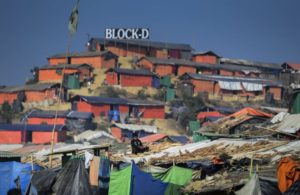The Rohingya crisis – a year on
 A year after their exodus from horrific violence in Burma’s Rakhine State almost a million Rohingya people are living in tents in a precarious part of southern Bangladesh near the town of Cox’s Bazar.
A year after their exodus from horrific violence in Burma’s Rakhine State almost a million Rohingya people are living in tents in a precarious part of southern Bangladesh near the town of Cox’s Bazar.
They are enduring a battering from the seasonal monsoon rains and the capricious waters of the Bay of Bengal.
Plastic and bamboo shelters clinging to clay mounds are subject to rain triggered mudslides and lashing wind and rain wreaking havoc across the 26 square kilometres of what has quickly become the world’s largest refugee camp.
The October-November cyclone season looms as a potential disaster. But the Rohingya refugees themselves have been trying to cyclone proof their own home digging drains and watercourses, building tracks and bridges and sandbagging slopes.
The Rohingya, young and old, women and men, display an inner-strength. Generations of statelessness and persecution has left them proudly resilient. They have so little, yet remain community-oriented. I can now begin to comprehend how orphaned children, single women, as well as injured and disabled individuals, all managed to flee to this land of refuge from the Rakhine.
An astonishing 80 per cent of refugees in the camps are women and children who dream of resuming normal lives
A year ago, the most recent influx of Rohingya into Bangladesh began when around 500,000 refugees arrived within a month.
The Government and people of Bangladesh have been e4xemplary in their response to the crisis.
But more is needed. A Joint Response Plan (JRP) launched in March 2018 as an appeal for $US951 million, to assist 1.3 million people including 884,000 Rohingya and 336,000 affected Bangladeshis.
But this is just a third funded, at 34 per cent. Urgent funding is critically required to meet life-saving humanitarian needs.
More than half the appeal is for food, water, sanitation, hygiene, shelter and non-food items combined. Food alone is 25 per cent of the overall appeal while just 18 per cent of food security needs are funded.
The Camps are dangerously congested, and most refugees lack adequate shelter from high winds and heavy rains.
The children have lacked education for years: in Rakhine they were denied, now there are no funds and access to quality education to prevent a generation of lost children.
A year on, the Rohingya crisis is arguably the most globally critical refugee crisis in terms of the numbers of people affected.
The sheer numbers are exacerbated by location, terrain and climate, adding to the complexity of the response.
A new book by two Australian academics explores the long-running tripartite conflict between the Rohingya, Rakhine and the Burman-led state and offers a new analysis of the complexities of the current crisis
Deakin University academics Anthony Ware and Costas Laoutides argue in the book ‘Myanmar’s Rohingya Conflict’ that what has happened in Rakhine State is complex and multi-faceted.
“There are many perspectives and fears at play here. All require respectful acknowledgement, as many facts on the ground are not yet established. Neither are all the facts underlying the historical background of this conflict yet clear. It is significant that all major protagonists frame this multi-faceted crisis very differently,” the researchers say.
“The Rohingya claim a centuries-or millennia-long history in this land. Most others in Myanmar claim they are recent or illegal Bengali migrants. The name Rohingya is strongly claimed by the Muslims, and hotly contested by others. The politics around names is not incidental in a nation whose own name is disputed,” they say.
The pair say that many people I Burma are angry, claiming that the international perception is biased and partial, and based on selective reporting. They point out that more than half the non-Rohingya population in Northern Rakhine state has also been displaced.
And they say opinion in Burma says that the military crackdown was in response to attacks by the Arakan Rohingya Salvation Army (ARSA) on police posts.
“ARSA claimed that its actions were in defence of Rohingya communities, in response to decades of marginalisation, persecution and harassment by security forces,” the authors says.
They say that there is a view in Burma that ARSA’s strategy was precisely to provoke a large exodus to win international sympathy.
“One thing is clear: the situation in Bangladesh requires immediate humanitarian and political responses. But it is too easy to opt for simplistic, black and white positions,” the researchers say.
Thy authors say boycotts and sanctions would be counterproductive, harming prospects for long-term reconciliation.
“Australia is well placed to support long-term reconciliation and economic development, something disengagement will only undermine,” they say.
“Australia should lead the international community in pledging to support its implementation. We should strongly state our commitment to principled engagement with those working for progressive change and democratic reform, while committing to long-term plans for the economic development of this, the poorest region of the country.
“Assistance is required to strengthen the rule of law and rebuild robust educational and health infrastructures which can help promote social cohesion and communal coexistence. Cultural reconciliation through dialogue and civil society interactions will require long-term support.
“At the same time, Australia can call for a robust and just process for the repatriation of displaced Rohingya people. This would include guarantees for their security and human rights, transparency and limits on the exercise of military power in the region, and a firm commitment to quickly restoring Rohingya citizenship,” the researchers says.
Laurie Nowell
AMES Australia Senior Journalist












